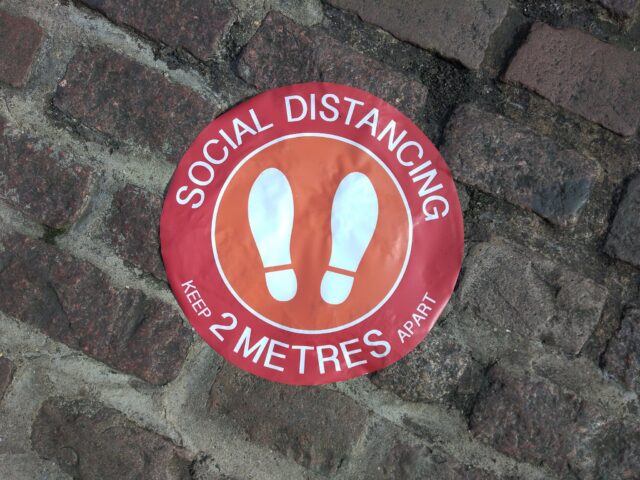Like it or not, we’re facing a new normal where businesses can reopen, but only while following new rules that combine freedom to trade with personal safety [writes Adam Bernstein]. The balancing act of keeping the economy alive while keeping coronavirus at bay isn’t an easy one to juggle. However, there are a number of steps that the British Retail Consortium is suggesting firms take to allow some form of normal service to return.
But before we delve into the detail of what needs to be done, management will need to consider its own circumstances – business sector, products and services supplied, physical layout of premises and perception of risk – when deciding what to initiate and the changes that need to be made. Whatever is decided, the key to success is communication with employees, customers, and suppliers alike noting that safety comes first, and business should come second.
Social distancing – outside
The biggest challenge businesses will face is how to implement social distancing both in and outside of the premises. The obvious solution to both is to control the entry and exit points into and out of the store with, ideally, one way in and one way out (apart from emergency exits); doors should be, depending on the weather, left open to avoid being touched. By extension, the number of people allowed into the store at any one time should be limited based on the attributes of the premises and how it is laid out. Remember – official UK guidance requires a gap of two metres between people.
To enforce social distancing barriers may be needed to shepherd movement and also, if necessary, prevent consumers joining uncontrolled queues. No one necessarily likes distancing rules but they’re necessary; clearly marked signs should be placed where appropriate to explain the measures that have been imposed, and markers – possibly tape – should be used to note where people should queue. Depending on what is around, it may be necessary to coordinate action with nearby premises to avoid queues clashing.
Many will carry their own hand sanitisers and disinfectant wipes, but it won’t hurt to provide the same around the store to visibly show customers that the business is proactively wiping down surfaces, handles, baskets and trolleys – anything that individuals may touch.
Social distancing – inside
Maintaining social distancing inside the premises is as important – if not more so – than outside. And just as markings will have been placed on the pavement outside, so they need to be placed inside, especially to mark out areas near tills to improve spacing if tills cannot be separated. Tills should have plastic screens as protection for checkout staff while keypads and screens should be cleaned after use if contactless payments cannot be made – cash should be actively discouraged where possible. Some stores have implemented a one-way system for controlling movement either with tape or barriers. Again, signs and PA system announcements will help the public understand the measures that have been implemented.
All of this applies to any part of the store that a customer may go, including order collection points and any confined spaces such as lifts. If clothing is on offer and a changing room is normally involved, thought should be given to closing it or at the minimum, finding a way to maintain social distancing.
And where bulky items are concerned, customers should be told in advance if there’s (no) help to move these items to vehicles; where help is offered, staff should be offered appropriate protection.
Being a retail operation means that by definition product lines need replenishing. The advice here is to aim to do this out of hours. If this cannot be done, then steps should be taken to close off the sections that are being restocked.
Many premises will have toilets that can be used (in an ‘emergency’) by the public as well as staff. Thought should be given as to whether they should be closed or only accessed on request. No matter the plan, they should be regularly cleaned with attention paid to doors, handles, seats, flushing mechanisms and taps.
Staffing matters
Staff are the backbone of a business and they must be made fully aware of what is expected of them in maintaining and demonstrating social distancing both in the front of the store and anywhere the public doesn’t have access to. But just as important as social distancing is the need to remind staff to regularly wash their hands – soap and towels should be provided – while regularly cleaning surfaces that staff touch; during breaks or other appropriate moments, these areas should be properly cleaned. It follows that supplies of gloves, masks and face visors ought to be acquired for those that want to use them – but those using reusable items should be reminded to regularly and properly clean them. Tools and objects such as pens shouldn’t be shared.
And to follow on from the government’s advice in March, staff should be reminded that they should not turn up to work if they’re unwell or showing symptoms; and to keep the risk of the spread of coronavirus to the minimum, staff should ideally be rostered to work in teams that do not change.
Lastly, where there’s a communal rest area, all of the above applies to the point that if necessary, it may have to be closed if social distancing cannot be maintained. Hands should be washed using soap and water for 20 seconds before and after eating and thought should be given to introducing a staggered break rota to avoid crowding; chairs and tables should be spaced out.
Track stock
Business success once lockdown ends will depend on what a firm is able to offer its customers when they want it. This starts with understanding lines and what sold in the year before lockdown. Look to see which products were in most demand and what sold poorly. Consider not just how much was sold of each item by what proportion of the stock was sold; remember, that it’s just as damaging to have too much of an item in stock eating up working capital. If there’s no sales data to help understand the position, then rectify this going forward.
Use technology to handle office work
Any business worth its salt should be busy front of house. However, being busy means more work behind the scenes. With a plethora of technology from EPoS to computers and accounts packages, firms should be taking advantage of anything that eases the burden of handling tasks like accounting, billing, collecting customer data and presenting and automating business transactions.
Watch sales and expenses
Depending on the level of pent up demand, how the firm has marketed itself during the shutdown and the state of the economy, there may be a frenetic restart of business or a gentle build up. Either way, sales and expenses need to be carefully watched to avoid running out of cash from either runaway bills or overtrading.
Again, as before, use automation and technology to monitor monies in and out. Some banks, Starling is a good example, allow for instant notification of any transactions.
Don’t forget to market
Quite simply, every business must stand out amongst its rivals to ensure that customers beat a path to its door. Find a promotion to focus on – something that offers a call to action to customers to entice them in to buy; try to recreate the loyalty that existed before the lockdown. And use every tool available including email, which offers a high conversion rate if a good list is used; social media – even with paid-for options – can be a great way to promote products and services; and both gather and use customer data to create a better email list for future promotions and offerings. Consider running a promotion that offers a discount in exchange for an email address.
















